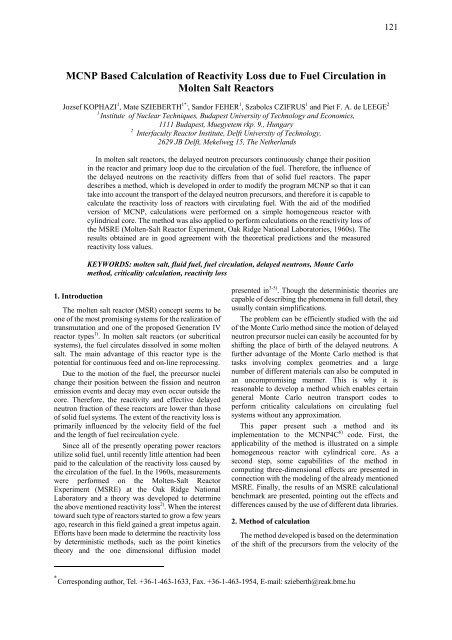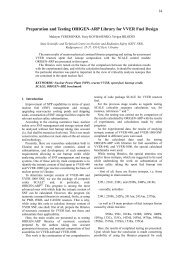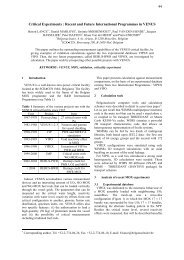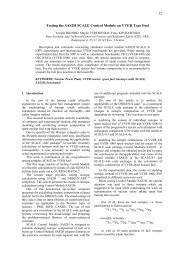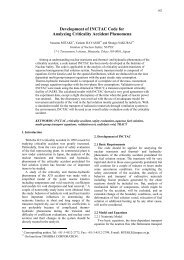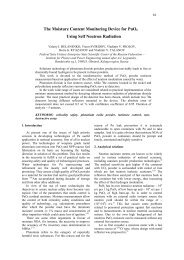MCNP Based Calculation of Reactivity Loss due to Fuel Circulation in
MCNP Based Calculation of Reactivity Loss due to Fuel Circulation in
MCNP Based Calculation of Reactivity Loss due to Fuel Circulation in
Create successful ePaper yourself
Turn your PDF publications into a flip-book with our unique Google optimized e-Paper software.
121<strong>MCNP</strong> <strong>Based</strong> <strong>Calculation</strong> <strong>of</strong> <strong>Reactivity</strong> <strong>Loss</strong> <strong>due</strong> <strong>to</strong> <strong>Fuel</strong> <strong>Circulation</strong> <strong>in</strong>Molten Salt Reac<strong>to</strong>rsJozsef KOPHAZI 1 , Mate SZIEBERTH 1*, , Sandor FEHER 1 , Szabolcs CZIFRUS 1 and Piet F. A. de LEEGE 21 Institute <strong>of</strong> Nuclear Techniques, Budapest University <strong>of</strong> Technology and Economics,1111 Budapest, Muegyetem rkp. 9., Hungary2 Interfaculty Reac<strong>to</strong>r Institute, Delft University <strong>of</strong> Technology,2629 JB Delft, Mekelweg 15, The NetherlandsIn molten salt reac<strong>to</strong>rs, the delayed neutron precursors cont<strong>in</strong>uously change their position<strong>in</strong> the reac<strong>to</strong>r and primary loop <strong>due</strong> <strong>to</strong> the circulation <strong>of</strong> the fuel. Therefore, the <strong>in</strong>fluence <strong>of</strong>the delayed neutrons on the reactivity differs from that <strong>of</strong> solid fuel reac<strong>to</strong>rs. The paperdescribes a method, which is developed <strong>in</strong> order <strong>to</strong> modify the program <strong>MCNP</strong> so that it cantake <strong>in</strong><strong>to</strong> account the transport <strong>of</strong> the delayed neutron precursors, and therefore it is capable <strong>to</strong>calculate the reactivity loss <strong>of</strong> reac<strong>to</strong>rs with circulat<strong>in</strong>g fuel. With the aid <strong>of</strong> the modifiedversion <strong>of</strong> <strong>MCNP</strong>, calculations were performed on a simple homogeneous reac<strong>to</strong>r withcyl<strong>in</strong>drical core. The method was also applied <strong>to</strong> perform calculations on the reactivity loss <strong>of</strong>the MSRE (Molten-Salt Reac<strong>to</strong>r Experiment, Oak Ridge National Labora<strong>to</strong>ries, 1960s). Theresults obta<strong>in</strong>ed are <strong>in</strong> good agreement with the theoretical predictions and the measuredreactivity loss values.KEYWORDS: molten salt, fluid fuel, fuel circulation, delayed neutrons, Monte Carlomethod, criticality calculation, reactivity loss1. IntroductionThe molten salt reac<strong>to</strong>r (MSR) concept seems <strong>to</strong> beone <strong>of</strong> the most promis<strong>in</strong>g systems for the realization <strong>of</strong>transmutation and one <strong>of</strong> the proposed Generation IVreac<strong>to</strong>r types 1) . In molten salt reac<strong>to</strong>rs (or subcriticalsystems), the fuel circulates dissolved <strong>in</strong> some moltensalt. The ma<strong>in</strong> advantage <strong>of</strong> this reac<strong>to</strong>r type is thepotential for cont<strong>in</strong>uous feed and on-l<strong>in</strong>e reprocess<strong>in</strong>g.Due <strong>to</strong> the motion <strong>of</strong> the fuel, the precursor nucleichange their position between the fission and neutronemission events and decay may even occur outside thecore. Therefore, the reactivity and effective delayedneutron fraction <strong>of</strong> these reac<strong>to</strong>rs are lower than those<strong>of</strong> solid fuel systems. The extent <strong>of</strong> the reactivity loss isprimarily <strong>in</strong>fluenced by the velocity field <strong>of</strong> the fueland the length <strong>of</strong> fuel recirculation cycle.S<strong>in</strong>ce all <strong>of</strong> the presently operat<strong>in</strong>g power reac<strong>to</strong>rsutilize solid fuel, until recently little attention had beenpaid <strong>to</strong> the calculation <strong>of</strong> the reactivity loss caused bythe circulation <strong>of</strong> the fuel. In the 1960s, measurementswere performed on the Molten-Salt Reac<strong>to</strong>rExperiment (MSRE) at the Oak Ridge NationalLabora<strong>to</strong>ry and a theory was developed <strong>to</strong> determ<strong>in</strong>ethe above mentioned reactivity loss 2) . When the <strong>in</strong>terest<strong>to</strong>ward such type <strong>of</strong> reac<strong>to</strong>rs started <strong>to</strong> grow a few yearsago, research <strong>in</strong> this field ga<strong>in</strong>ed a great impetus aga<strong>in</strong>.Efforts have been made <strong>to</strong> determ<strong>in</strong>e the reactivity lossby determ<strong>in</strong>istic methods, such as the po<strong>in</strong>t k<strong>in</strong>eticstheory and the one dimensional diffusion modelpresented <strong>in</strong> 3-5) . Though the determ<strong>in</strong>istic theories arecapable <strong>of</strong> describ<strong>in</strong>g the phenomena <strong>in</strong> full detail, theyusually conta<strong>in</strong> simplifications.The problem can be efficiently studied with the aid<strong>of</strong> the Monte Carlo method s<strong>in</strong>ce the motion <strong>of</strong> delayedneutron precursor nuclei can easily be accounted for byshift<strong>in</strong>g the place <strong>of</strong> birth <strong>of</strong> the delayed neutrons. Afurther advantage <strong>of</strong> the Monte Carlo method is thattasks <strong>in</strong>volv<strong>in</strong>g complex geometries and a largenumber <strong>of</strong> different materials can also be computed <strong>in</strong>an uncompromis<strong>in</strong>g manner. This is why it isreasonable <strong>to</strong> develop a method which enables certa<strong>in</strong>general Monte Carlo neutron transport codes <strong>to</strong>perform criticality calculations on circulat<strong>in</strong>g fuelsystems without any approximation.This paper present such a method and itsimplementation <strong>to</strong> the <strong>MCNP</strong>4C 6) code. First, theapplicability <strong>of</strong> the method is illustrated on a simplehomogeneous reac<strong>to</strong>r with cyl<strong>in</strong>drical core. As asecond step, some capabilities <strong>of</strong> the method <strong>in</strong>comput<strong>in</strong>g three-dimensional effects are presented <strong>in</strong>connection with the model<strong>in</strong>g <strong>of</strong> the already mentionedMSRE. F<strong>in</strong>ally, the results <strong>of</strong> an MSRE calculationalbenchmark are presented, po<strong>in</strong>t<strong>in</strong>g out the effects anddifferences caused by the use <strong>of</strong> different data libraries.2. Method <strong>of</strong> calculationThe method developed is based on the determ<strong>in</strong>ation<strong>of</strong> the shift <strong>of</strong> the precursors from the velocity <strong>of</strong> the* Correspond<strong>in</strong>g author, Tel. +36-1-463-1633, Fax. +36-1-463-1954, E-mail: szieberth@reak.bme.hu
fuel and the sampled lifetime <strong>of</strong> the nuclide. Thedelayed neutron is born <strong>in</strong> this new position.The above method is realized <strong>in</strong> <strong>MCNP</strong>4C.Although this is a highly flexible code and can handlethe delayed neutrons <strong>in</strong> every detail, it cannot accountfor the motion <strong>of</strong> delayed neutron emitters. Therefore,modifications were <strong>in</strong>troduced <strong>in</strong> <strong>to</strong> the code. With theaid <strong>of</strong> the modified version the multiplication fac<strong>to</strong>rcan be determ<strong>in</strong>ed at different fuel velocities anddifferent circulation cycle lengths.The method can obviously be implemented for agiven geometry, thus newer and newer versions <strong>of</strong> theprogram should be created when calculat<strong>in</strong>g reac<strong>to</strong>rswith different geometries. This is <strong>due</strong> <strong>to</strong> the fact thatthe motion <strong>of</strong> the neutron birth places should bedescribed accord<strong>in</strong>g <strong>to</strong> the geometry <strong>in</strong> question.Concern<strong>in</strong>g the simulation <strong>of</strong> the precursor nuclei,the simplest geometry is <strong>of</strong>fered by a cyl<strong>in</strong>dricalhomogeneous core. The delayed neutron emitter isborn at the place <strong>of</strong> fission, where a correspond<strong>in</strong>gdecay time is sampled. By use <strong>of</strong> the velocity the length<strong>of</strong> time is determ<strong>in</strong>ed <strong>in</strong> which the emitter nucleuswould reach the upper plane <strong>of</strong> the cyl<strong>in</strong>drical core. Ifthis time is longer than that sampled for the emitter <strong>to</strong>decay, the distance traveled until the decay iscalculated and the po<strong>in</strong>t <strong>of</strong> neutron creation is shiftedwith this distance parallel with the axis <strong>of</strong> the core. Ifthe sampled decay time is longer than that needed forthe emitter <strong>to</strong> reach the cover plane, the simulationtakes the emitter <strong>of</strong>f the core and it enters the primary(external) loop. In the next step it is determ<strong>in</strong>edwhether the emitter can re-enter the core before itdecays. If the sampled decay time is shorter than thetime the emitter needs <strong>to</strong> reach the lower plane and then<strong>to</strong> re-enter the core, the neutron that would begenerated by the delayed neutron emitter is not tracked.In the opposite case the emitter re-enters the core. Theentrance position along the base surface is sampleduniformly. From now on, the emitter moves upwardparallel with the axis <strong>of</strong> the core and the decay positioncan be modeled accord<strong>in</strong>g <strong>to</strong> the algorithm describedabove. The above steps are repeated as long as thedecay position <strong>of</strong> the emitter is not determ<strong>in</strong>ed.In the case <strong>of</strong> a more complex geometry the details<strong>of</strong> the algorithm are more complicated as well,however, the basic pr<strong>in</strong>ciple is the same as thatdescribed <strong>in</strong> the previous paragraph.Two subrout<strong>in</strong>es <strong>of</strong> the <strong>MCNP</strong> source code weremodified: COLIDK (which generates the fissionneutrons for the next cycle <strong>of</strong> the simulation) andSOURCK (which starts the required number <strong>of</strong> fissionneutrons for the next cycle).In order <strong>to</strong> theoretically estimate what results can beexpected, a simple formula was derived <strong>in</strong> a onedimensional model. Dur<strong>in</strong>g the operation <strong>of</strong> the reac<strong>to</strong>r,a precursor nucleus born at height z <strong>in</strong> the core starts <strong>to</strong>move parallel <strong>to</strong> the axis <strong>of</strong> the core. The probabilitythat it exits from the core is:λ( z−H)vPz ( ) = e(1)where λ is the decay constant <strong>of</strong> the precursor, v is thefuel velocity <strong>in</strong> the core, and H is the height <strong>of</strong> thecore. Assum<strong>in</strong>g that the spatial distribution <strong>of</strong> theprecursors is uniform along the z axis (i.e. there is nochange <strong>in</strong> the flux), we can easily obta<strong>in</strong> the follow<strong>in</strong>gformula by <strong>in</strong>tegrat<strong>in</strong>g (1) over the entire core:61 ∆ ρ = 1 −β∑i=1⎡ ⎛ −λ⎞⎤β ⎢1v Hi− ⎜ ⎟−vi1 e⎥, (2)⎢⎣λiH ⎝ ⎠⎥⎦where ∆ρ is the reactivity loss <strong>in</strong> $, β is the delayedneutron fraction, β i are the delayed neutron fractions,and λ i are the decay constants <strong>of</strong> the <strong>in</strong>dividual delayedneutron groups.3. <strong>Calculation</strong>sFirst, calculations were performed for a simplehomogeneous cyl<strong>in</strong>drical reac<strong>to</strong>r, <strong>in</strong> which 100%enriched 235 UF 3 is dissolved <strong>in</strong> 32 mol% BeF2 + 68mol% 7 LiF molten salt with a concentration <strong>of</strong> 4.8mol%. The diameter and height <strong>of</strong> the reac<strong>to</strong>r are 80 cmand 100 cm, respectively. The change <strong>in</strong> reactivity was<strong>in</strong>vestigated for cases <strong>of</strong> different velocities andrecirculation times. The velocity was <strong>in</strong> the <strong>in</strong>tervalbetween 0 and 100 cm/s, while the recirculation timewas changed between 2 s and <strong>in</strong>f<strong>in</strong>ity (which was <strong>in</strong>fact modeled as 100000 s). The results are shown <strong>in</strong>Figures 1 and 2.<strong>Reactivity</strong> <strong>Loss</strong> [$]1.000.900.800.700.600.500.400.300.200.100.000 20 40 60 80 100<strong>Fuel</strong> Velocity [cm/s]<strong>MCNP</strong>TheoreticalFig. 1 <strong>Reactivity</strong> loss vs. fuel velocity, <strong>in</strong> the case <strong>of</strong><strong>in</strong>f<strong>in</strong>itely long (100000 s) recirculation timeThe results obta<strong>in</strong>ed us<strong>in</strong>g the modified <strong>MCNP</strong> meetthe expectations based on theoretical considerations.As it can be seen <strong>in</strong> Figure 1, the trends <strong>of</strong> the results
are similar but the calculated reactivity loss is higher,especially at higher velocities. This fact agrees <strong>to</strong> theexpectations as the simple theory considers only theneutron loss <strong>due</strong> <strong>to</strong> ex-core emissions assum<strong>in</strong>g a flataxial flux distribution while the reduction <strong>in</strong> thedelayed neutron worth <strong>due</strong> <strong>to</strong> the change <strong>of</strong> the positionis neglected. However, the results show that the lattereffect is not negligible.1.000.90with<strong>in</strong> the space occupied by fuel. Accord<strong>in</strong>gly, themost substantial difference compared <strong>to</strong> the algorithmfor the cyl<strong>in</strong>drical homogeneous reac<strong>to</strong>r is that fornuclei enter<strong>in</strong>g the central graphite lattice from thelower plenum one fuel channel should be selected. Thisis realized by tak<strong>in</strong>g the emitter nucleus <strong>to</strong> the closestfuel channel, sampl<strong>in</strong>g an x-y position from entirecross section <strong>of</strong> the given channel uniformly. The x-yposition <strong>of</strong> a nucleus exit<strong>in</strong>g a channel is sampleduniformly over the whole area <strong>of</strong> the correspond<strong>in</strong>gunit cell. The emitter moves vertically <strong>in</strong> the twoplenums and <strong>in</strong>side the fuel channel.0.800.70<strong>Reactivity</strong> <strong>Loss</strong> [$]0.600.500.400.30Tc=100000sTc=5sTc=2sTc=10s0.200.100.000 20 40 60 80 100<strong>Fuel</strong> Velocity [cm/s]Fig. 2 <strong>Reactivity</strong> loss calculated by modified <strong>MCNP</strong>for the homogeneous cyl<strong>in</strong>drical reac<strong>to</strong>r with differentrecirculation timesIn order <strong>to</strong> demonstrate the capabilities <strong>of</strong> themethod <strong>in</strong> more complex geometry and <strong>to</strong> comparecalculational results <strong>to</strong> measured ones it was plausible<strong>to</strong> set up a model and perform calculations for theMSRE.The MSRE was a graphite moderated reac<strong>to</strong>r, at thebeg<strong>in</strong>n<strong>in</strong>g fuelled with medium enriched 235 U, whichwas replaced with 233 U <strong>in</strong> the later experiments. Thescheme <strong>of</strong> the reac<strong>to</strong>r is shown <strong>in</strong> Figure 3 7) . The fuelwas circulat<strong>in</strong>g <strong>in</strong> channels formed between graphiteblocks <strong>in</strong> the central part <strong>of</strong> the core, while the volumesclos<strong>in</strong>g the reac<strong>to</strong>r on the bot<strong>to</strong>m and <strong>to</strong>p sides arehomogeneous fuel spaces, called plenums.At the application <strong>of</strong> the above mentioned methodfor the MSRE there was a po<strong>in</strong>t <strong>of</strong> great importance:the simulation had <strong>to</strong> ensure that dur<strong>in</strong>g the motion <strong>of</strong>the delayed neutron emitter nuclei they always stayFig. 3 Scheme <strong>of</strong> the MSRE reac<strong>to</strong>r<strong>Based</strong> on the <strong>in</strong>complete and rather poor dataavailable on the experiments performed <strong>in</strong> the 60s, amodel was worked out and implemented <strong>to</strong> the <strong>MCNP</strong>,describ<strong>in</strong>g the MSRE more or less adequately <strong>in</strong> terms<strong>of</strong> reac<strong>to</strong>r physics. This model was not expected <strong>to</strong>reflect the measurement data at high accuracy.However, it was suitable <strong>to</strong> <strong>in</strong>vestigate certa<strong>in</strong>three-dimensional effects.Accord<strong>in</strong>gly, with the aid <strong>of</strong> this model the <strong>in</strong>fluence<strong>of</strong> replac<strong>in</strong>g the cyl<strong>in</strong>drical plenums below and abovethe reac<strong>to</strong>r core with a more realistic elliptical andspherical structure, respectively, has been exam<strong>in</strong>ed.The vertical section <strong>of</strong> the correspond<strong>in</strong>g <strong>MCNP</strong> model
is shown on Figure 4.The reactivity losses obta<strong>in</strong>ed with the cyl<strong>in</strong>dricaland rounded models were 141 ± 13 and 191 ± 22 pcm,respectively. By compar<strong>in</strong>g the difference <strong>to</strong> themeasured reactivity loss, which was 212 pcm, it can beconcluded, that the shape <strong>of</strong> the regions surround<strong>in</strong>gthe core at the bot<strong>to</strong>m and <strong>to</strong>p sides does have asignificant impact on the calculated reactivity loss.The other calculational experiment is related <strong>to</strong> thefuel flow velocity pr<strong>of</strong>ile. In this case, the flow rate wasdoubled <strong>in</strong> some portion <strong>of</strong> the fuel channels situated<strong>in</strong>side the graphite block (see Figure 5) such that the<strong>to</strong>tal flow rate rema<strong>in</strong>ed constant. The result obta<strong>in</strong>edwas that <strong>in</strong> this case the reactivity loss <strong>in</strong>creased fromthe earlier 141 ± 13 <strong>to</strong> 173 ± 13 pcm. From this itfollows that the flow pr<strong>of</strong>ile also has substantial<strong>in</strong>fluence on the phenomenon <strong>to</strong> be calculated.plenum <strong>of</strong> 17.15 cm height filled only with fuel.Double velocity areaFig. 5 Horizontal section <strong>of</strong> the MSRE model used <strong>to</strong>study the effect <strong>of</strong> the velocity pr<strong>of</strong>ileThe flow velocity <strong>of</strong> the fuel <strong>in</strong> the lattice structureis 19.67 cm/s, while that <strong>in</strong> the clos<strong>in</strong>g plenums is5.07 cm/s.Fig. 4 Vertical section <strong>of</strong> the MSRE model used <strong>to</strong>study the effect <strong>of</strong> rounded plenums (spherical <strong>to</strong>p,elliptical bot<strong>to</strong>m)In view <strong>of</strong> the <strong>in</strong>completeness <strong>of</strong> the data availableon the MSRE project, the participants <strong>of</strong> the MOSTproject 8) def<strong>in</strong>ed a model for the MSRE <strong>in</strong> the frame <strong>of</strong>a calculational benchmark. The third application <strong>of</strong> ourmethod was the calculation <strong>of</strong> this benchmark.<strong>Based</strong> on the data gathered with<strong>in</strong> the MOST project,the model has been elaborated as follows. The reac<strong>to</strong>ris approximated as a cyl<strong>in</strong>der <strong>of</strong> 142.4 cm diameter and166.3 cm height, which is filled with the graphitelattice structure shown <strong>in</strong> Figure 6. The lattice pitch is4.213 cm. The side lengths <strong>of</strong> the rectangular crosssection <strong>of</strong> the fuel channels formed <strong>in</strong>side the graphiteare 3.03 cm x 1.15 cm. The cyl<strong>in</strong>drical system filledwith the lattice is covered on <strong>to</strong>p and bot<strong>to</strong>m sides by aFig. 6 A horizontal section <strong>of</strong> the MSRE calculationalbenchmark modelThe composition <strong>of</strong> the fuel has also been set upaccord<strong>in</strong>g <strong>to</strong> the MOST project (see Table 1). Thepower <strong>of</strong> the reac<strong>to</strong>r was assumed <strong>to</strong> be zero, so thetemperature <strong>of</strong> both the fuel and graphite modera<strong>to</strong>r istaken <strong>to</strong> be 918 K, which was used <strong>in</strong> the experiment.It was decided <strong>to</strong> use two different delayed neutrondata sets. Besides the recent values <strong>of</strong> JEF-2.2 9) theorig<strong>in</strong>al ORNL data (see Table 3) were used, as well, <strong>in</strong>
the attempt <strong>to</strong> narrow down the discrepancy <strong>to</strong> theexperiment. As delayed neutron spectra were notavailable from the ORNL, therefore we used theprovided β eff values 2) and assumed prompt fissionspectrum for the delayed neutrons. This approximationactually corresponds <strong>to</strong> the def<strong>in</strong>ition <strong>of</strong> the β eff , andshould have the same effect as if we used the real βvalues <strong>to</strong>gether with the proper delayed neutronspectra.Table 1 <strong>Fuel</strong> composition <strong>of</strong> MSREIso<strong>to</strong>peA<strong>to</strong>mic ratio [%]235U 233U7 Li 2.64E-01 2.64E-019 Be 1.18E-01 1.19E-01Zr 2.03E-02 2.03E-02F 5.94E-01 5.96E-01233 U 0 4.44E-04234 U 0 4.37E-05235 U 1.04E-03 9.27E-06238 U 2.21E-03 1.86E-05239 Pu 0 8.89E-06The <strong>MCNP</strong> model <strong>of</strong> the reac<strong>to</strong>r was worked outaccord<strong>in</strong>g <strong>to</strong> the above considerations. A horizontaland vertical section <strong>of</strong> the model is seen <strong>in</strong> Figures 6and 7, respectively.acceptable <strong>in</strong> view <strong>of</strong> the standard deviation <strong>of</strong> thecalculations and measurements and the uncerta<strong>in</strong>ty <strong>of</strong>the fuel composition. The results obta<strong>in</strong>ed with ORNLdelayed neutron data show that method applied <strong>in</strong> thelack <strong>of</strong> delayed neutron spectra is feasible, however,the modern data sets can be considered as superior.Table 2 The calculated and measured reactivity loss <strong>of</strong>the MSRE with two types <strong>of</strong> fuel<strong>Fuel</strong> k eff Measurementρ loss [pcm]<strong>Calculation</strong>ORNL JEF-2.2Standarddeviation235 U 1,05980 212 224 244 13233 U 1,12714 100 ± 5% 131 85 134. ConclusionIn the work presented <strong>in</strong> this paper a Monte Carlomethod based calculational procedure has beendeveloped for the determ<strong>in</strong>ation <strong>of</strong> the reactivity loss <strong>of</strong>reac<strong>to</strong>rs with circulat<strong>in</strong>g fuel. The calculationaltechnique has been implemented by <strong>in</strong>troduc<strong>in</strong>gmodifications <strong>to</strong> the <strong>MCNP</strong>4C code. The applicability<strong>of</strong> the technique was first demonstrated on a simplegeometry homogeneous reac<strong>to</strong>r, for which the resultsobta<strong>in</strong>ed agreed well with the expectations formtheoretical considerations.<strong>Calculation</strong>s were performed for the MSRE, as well,<strong>in</strong> order <strong>to</strong> <strong>in</strong>vestigate more complicated,three-dimensional effects and <strong>to</strong> be able <strong>to</strong> comparewith measured values. The results confirm that theapplication <strong>of</strong> the Monte Carlo method can be veryimportant if the aim is the simulation <strong>of</strong> a real geometrywith the best approximation possible. The need for abetter approximation was demonstrated by show<strong>in</strong>gthat the reactivity loss was significantly affected bychange <strong>of</strong> the fuel velocity pr<strong>of</strong>ile and the shape <strong>of</strong> thecore conta<strong>in</strong>ment. The values obta<strong>in</strong>ed for the MSREbenchmark <strong>in</strong> the framework <strong>of</strong> the MOST projectshow that a reasonable estimation <strong>of</strong> the measuredvalues is achievable.ReferencesFig. 7 A vertical section <strong>of</strong> the MSRE calculationalbenchmark modelWe have applied the modified <strong>MCNP</strong> <strong>to</strong> calculatethe reactivity loss for both fuel compositions <strong>of</strong> thereac<strong>to</strong>r. The results are summarized <strong>in</strong> Table 2.It is seen that for the 235 U fuelled reac<strong>to</strong>r theagreement between the calculated (JEF-2.2) andmeasured reactivity loss values is very good. In thecase <strong>of</strong> 233 U, the calculational results can be considered1) D. J. Diamond, "Research Need for GenerationIV Nuclear Energy Systems", Proc. PHYSOR2002, Seoul, South Korea, 7-10-2002 (2002).2) "Zero-Power Physics Experiments on theMolten-salt Reac<strong>to</strong>r Experiment" ORNL4233,Oak Ridge National Lab., USA, (1968)3) G. Lapenta, P. Ravet<strong>to</strong>, and G. Ritter, "EffectiveDelayed Neutron Fraction for Fluid-<strong>Fuel</strong>Systems", Ann. Nucl. Energy, 27, 1523.4) G. Lapenta and P. Ravet<strong>to</strong>, "Basis Reac<strong>to</strong>rPhysics Problems <strong>in</strong> Fluid-<strong>Fuel</strong> RecirculatedReac<strong>to</strong>rs", Kerntechnik.
5) G. Lapenta, F. Mattioda, and P. Ravet<strong>to</strong>, "Po<strong>in</strong>tK<strong>in</strong>etic Model for Fluid <strong>Fuel</strong> Systems", Ann.Nucl. Energy, 28, 1759.6) J. F. e. al. Briesmeister, "<strong>MCNP</strong> - A GeneralMonte Carlo N-Particle Transport Code,Version 4C", Los Alamos National Labora<strong>to</strong>ry,Los Alamos, USA (2000).7) "Research, Test and Experimental Reac<strong>to</strong>rs",Direc<strong>to</strong>ry <strong>of</strong> Nuclear Reac<strong>to</strong>rs, Vol. V, IAEA,Vienna, (1964).8) M. Delpech, S. Dulla, C. Garzenne, J. Kópházi,J. Krepel, C. Lebrun, D. Lecarpentier, F.Mattioda, P. Ravet<strong>to</strong>, A. R<strong>in</strong>elski, M. Schikorr,and M. Szieberth, "Benchmark <strong>of</strong> DynamicSimulation Tools for Molten Salt Reac<strong>to</strong>rs",Proc. GLOBAL 2003, New Orleans, USA,16-11-2003 (2003).9) "The JEF-2.2 Nuclear Data Library", JEFFReport 17, NEA, Paris, France, (2000)Table 3 ORNL delayed neutron data<strong>Fuel</strong> Total Group 1 Group 2 Group 3 Group 4 Group 5 Group 6235 U β static [pcm] 640.5 21.1 140.2 125.4 252.8 74.0 27233 Uβ eff static [pcm] 666.1 22.3 145.7 130.7 262.8 76.6 28decay data [s -1 ] 0.0124 0.0305 0.111 0.301 1.14 3.01β static [pcm] 271.2 22.55 80.28 67.48 76.86 14.94 9.10β eff static [pcm] 289.38 23.76 85.76 71.9 82.14 15.79 10.03decay data [s -1 ] 0.0126 0.0337 0.139 0.325 1.13 2.5


